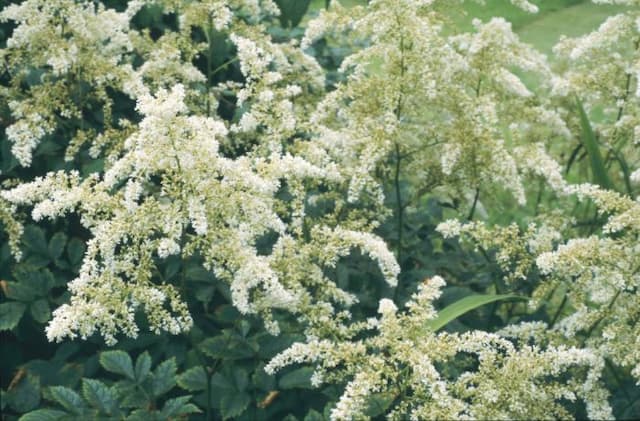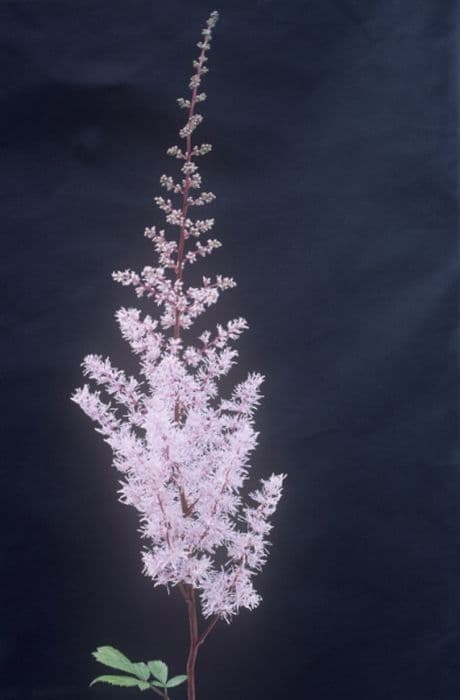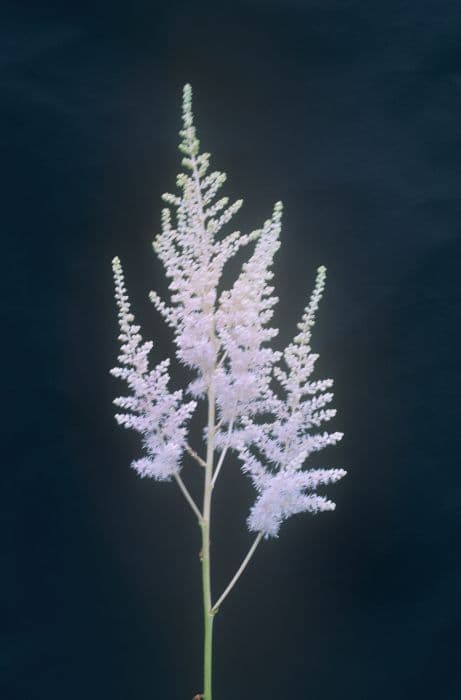Elf Rose Saxifrage Saxifraga 'Elf Rose' (15)

ABOUT
Saxifraga 'Elf Rose' is an ornamental plant known for its charming and delicate appearance. The visual appeal of this plant lies in its lush, green foliage and dainty pink flowers. The leaves are generally rounded, with a textured surface that may appear slightly serrated or scalloped on the edges, forming a low-growing mat at the base. The blooms of the 'Elf Rose' are particularly striking, featuring petite, star-shaped flowers atop slender, wiry stems. The petals are soft pink in color, offering a gentle contrast to the greenery below. These flowers cluster together in loose panicles, creating a frothy display that resembles a cloud of pastel hues. The plant exudes a refined beauty, making it a favorite amongst gardeners looking to add a touch of whimsy to rock gardens, borders, or as ground cover. Its overall visual effect is one of subtle grace and a fairy-like charm, evoking the magical ambiance their name suggests.
About this plant
 Names
NamesFamily
Saxifragaceae
Synonyms
Elf Rose Saxifrage, Fairy Rose Saxifrage
Common names
Saxifraga 'Elf Rose'
 Toxicity
ToxicityTo humans
The Elf Rose, a variety of Saxifraga, is generally not considered toxic to humans. There is no widespread documentation of poisonous effects from ingesting this plant, so symptoms of poisoning are not typically associated with it. However, as with any plant, individual allergic reactions or sensitivities can occur, so it is advisable to exercise caution and avoid eating any part of this plant.
To pets
The Elf Rose, a member of the Saxifraga genus, is not commonly known to be toxic to pets. There is limited information suggesting that it causes any harmful effects if ingested by animals such as dogs and cats. Therefore, there are no specific symptoms of poisoning associated with this plant. Nevertheless, it's always best to prevent pets from eating any non-food plants, as individual reactions can vary, and some pets might experience mild gastrointestinal upset if they consume plant material they're not accustomed to.
 Characteristics
CharacteristicsLife cycle
Perennials
Foliage type
Evergreen
Color of leaves
Green
Flower color
Pink
Height
0.5 feet (15 cm)
Spread
1 feet (30 cm)
Plant type
Herb
Hardiness zones
5
Native area
Europe
Benefits
 General Benefits
General Benefits- Aesthetic Appeal: Adds vibrant color and unique textures to gardens with its delicate rose-pink flowers.
- Low Maintenance: Requires minimal care, making it suitable for gardeners of all skill levels.
- Drought Tolerance: Once established, it has good resistance to drought, reducing the need for frequent watering.
- Ground Cover: Spreads effectively to cover bare spots, helping to suppress weeds and reduce soil erosion.
- Cold Hardy: Can survive in colder climates, often withstanding frost and low temperatures.
- Rock Gardens: Ideal for rock gardens due to its compact growth habit and capability to grow in rocky substrates.
- Border Planting: Its size and form make it a great choice for edges of paths or garden borders.
- Attracts Wildlife: Can attract butterflies and other beneficial insects, promoting biodiversity.
- Long Blooming: Offers a long blooming season, providing prolonged enjoyment of its flowers.
- Alpine Characteristic: Its alpine nature makes it a fascinating addition to alpine and high-altitude themed gardens.
- Container Gardening: Suitable for pots and containers due to its small size and contained growth.
- Versatility: Can be integrated into various garden styles, from casual cottage gardens to formal beds.
- Seasonal Interest: Adds interest to the garden in the spring and summer when it flowers.
- Erosion Control: On slopes or banks, the plant can help stabilize the soil with its root system.
- Easy Propagation: Can be easily propagated by division or offsets, allowing gardeners to expand their collection.
 Medical Properties
Medical PropertiesThis plant is not used for medical purposes.
 Air-purifying Qualities
Air-purifying QualitiesThis plant is not specifically known for air purifying qualities.
 Other Uses
Other Uses- Saxifraga 'Elf Rose' can be used as a natural pest deterrent in gardens, as its scent can be unpleasant to some insects.
- Due to its low-growing habit, it can be used for living mulches, suppressing weeds and maintaining soil moisture.
- The plant's dense foliage can provide microhabitats for beneficial insects, promoting biodiversity in the garden.
- It can be planted in cracks and crevices of walls or walkways to add greenery without the need for extensive soil.
- As a natural ground cover, Saxifraga 'Elf Rose' helps prevent soil erosion on slopes or in areas prone to heavy rains.
- The plant can be used in fairy gardens or miniature landscapes for a whimsical, delicate touch.
- In art, the unique rosettes of Saxifraga 'Elf Rose' can inspire patterns and motifs in fabric design or graphic illustrations.
- During winter, the evergreen leaves offer a touch of color in otherwise dormant gardens.
- The plant can be a living indicator of the pH level of soil; its preference for slightly alkaline conditions can signal the need for soil amendments.
- Enthusiasts of Saxifraga 'Elf Rose' can engage in specialist cultivation and hybridization to create new varieties and expand the range of appearances.
Interesting Facts
 Feng Shui
Feng ShuiThe Elf Rose is not used in Feng Shui practice.
 Zodiac Sign Compitability
Zodiac Sign CompitabilityThe Elf Rose is not used in astrology practice.
 Plant Symbolism
Plant Symbolism- Endurance: Saxifraga, named for its ability to break through rocks, symbolizes strength and the capacity to endure tough conditions.
- Determination: The hardy nature of the Elf Rose represents a person's determination to overcome obstacles.
- Persistence: Its persistent growth even in inhospitable environments represents staying power and tenacity.
- Delicacy: The delicate blooms of the Elf Rose suggest the idea of beauty in fragility, and the importance of being gentle in one’s approach.
- Affection: Often grown in gardens for their beauty, they can symbolize love and affection towards a friend or family member.
 Water
WaterThe Saxifraga 'Elf Rose', commonly known as Mossy Saxifrage, prefers consistent moisture, so water it whenever the top inch of soil feels dry to the touch. During the active growth period in spring and summer, this will typically be about once a week, but always check soil moisture before watering. Provide enough water to moisten the soil throughout the pot, which might be approximately 16 ounces for a small pot. Reduce watering in the winter months when the plant is not actively growing, likely every two weeks, depending on indoor conditions.
 Light
LightMossy Saxifrage thrives in conditions where it receives partial shade to filtered sunlight. It's best situated in a spot that avoids the intense afternoon sun, which can scorch the delicate leaves. An east or north-facing window would be an ideal location, or a shaded spot in a brighter room.
 Temperature
TemperatureMossy Saxifrage prefers cool to moderate temperatures, thriving in a range between 60°F and 75°F. It can tolerate temperatures down to about 50°F without damage and shouldn't be exposed to temperatures much higher than 80°F for prolonged periods. Ensure good ventilation if indoor temperatures start to rise to keep the plant in its optimal temperature range.
 Pruning
PruningPrune your Mossy Saxifrage to remove dead or wilted flowers and leaves, which encourages new growth and helps maintain a compact, attractive shape. Pruning is best done after flowering, typically in late spring or early summer. You can also trim back any excessively leggy stems at this time to promote denser foliage.
 Cleaning
CleaningAs needed
 Soil
SoilThe Fairy Saxifrage prefers a well-draining soil mix with added organic matter like leaf mold or compost to promote healthy growth. The best pH for this plant lies in the slightly acidic to neutral range, about pH 5.5 to 7. A mix of loam, peat, and coarse sand is ideal to provide the necessary drainage and aeration.
 Repotting
RepottingFairy Saxifrage should be repotted every 2-3 years to refresh the soil and accommodate root growth. It's best to repot in the spring when the plant resumes active growth.
 Humidity & Misting
Humidity & MistingFairy Saxifrage thrives in moderate humidity levels. It does well in typical household humidity but appreciates a boost in humidity if the air is particularly dry, for instance during winter when indoor heating systems are in use.
 Suitable locations
Suitable locationsIndoor
Place in bright, indirect light, with moderate humidity and cool temperatures.
Outdoor
Needs partial shade, moist soil, and protection from hot afternoon sun.
Hardiness zone
6-8 USDA.
 Life cycle
Life cycleSaxifraga 'Elf Rose', commonly known as Saxifrage or Rockfoil, begins its life cycle as a seed that germinates in cool, moist soil conditions in spring. Once the seedling emerges, it develops a rosette of leaves and starts to establish a strong root system. As it matures, Saxifrage produces a flowering stem with clusters of small, pink or white flowers that typically bloom in the late spring to early summer. After pollination, often by insects, the flowers develop into capsules containing tiny seeds. Once the seeds are dispersed, the parent plant continues to grow and can spread vegetatively by producing offsets. Saxifrage 'Elf Rose' is a perennial plant, which means it can live for several years, going through the cycle of growth, flowering, and dormancy annually.
 Propogation
PropogationPropogation time
Spring-Early Summer
Propogation: The Saxifraga 'Elf Rose', commonly known as Elf Rose Saxifrage, is typically propagated through division, which is the most popular method for this plant. This process should be done in the spring or early fall when the plant is not in full bloom. To propagate by division, carefully dig up the plants, ensuring a good amount of root on each clump. Once the plant is out of the ground, gently tease apart the clumps into smaller sections, each with several shoots and a portion of the root system. These sections can then be replanted immediately in well-draining soil, spaced at least 6 to 8 inches (approximately 15 to 20 centimeters) apart to allow room for growth. Water the new plants thoroughly after planting to help establish them. Division not only helps to propagate Elf Rose Saxifrage but also invigorates older clumps that may have become woody or less vigorous.









